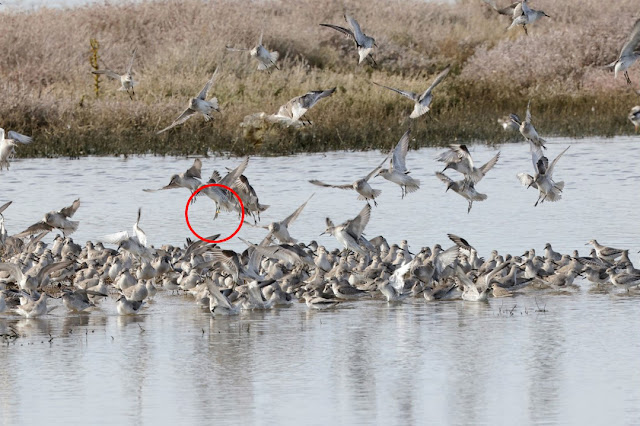30th March 2023
During my visit to Two Tree Island I was privileged to photograph whirling flocks of 1000-1500 Knot as they came in to roost on the salt lagoon. Following the publication of my blog I was contacted by Ed Keeble who has spent the last few years scanning the flocks of Knot wintering in Essex looking for colour-ringed birds so that he could trace their movements.
The reason that Ed contacted me was that it is difficult to read colour ring combinations on Knot that are hundreds of yards away on the mud flats, but many of my photos showed them coming to roost with their legs dangling as they came in to land. This gives some great opportunities to not only see some colour rings but also in sufficient detail to reliably record the combinations.
I provided Ed with a number of photos which he expanded and scanned and managed to find three birds with readable colour ring combinations. These were sent off to the colour-ringing scheme to find out when and where they were ringed and obtain a full history of subsequent sightings. But before I get to that it is probably worth providing a little background.
Essex holds internationally important numbers of wintering Knot, with numbers climbing in recent decades to around 50,000, with up to 25,000 on the Thames. Knot have been intensively studied using colour-rings over many years, but few reports are received in winter and very few of those come from the Thames, despite large flocks wintering there.
The wintering Knot do not arrive in Essex in numbers until November, having moulted on the Wash and the Waddensee, the latter being a very extensive stretch of mudflats along the coasts of The Netherlands, Germany and Denmark. It is likely that most of our Knot come over from the Waddensee in late autumn rather than from the Wash.
The wintering Knot in Essex stay until late February or early March and on departure from here, it is very likely that most cross direct to the Waddensee to moult into breeding plumage. About 70% of the total population of islandica Knot gathers on the Waddensee in spring and uses it as the launchpad for migration.
The wintering birds in Essex are from the subspecies which breeds in Greenland and north-east Canada. They do not breed in Iceland (despite the subspecific name “islandica”) or in Scandinavia. They leave the Waddensee in May and have two established routes in spring, with the majority travelling via Iceland, but with a proportion travelling up to the extreme tip of north Norway and then departing from there. The jury is still out on how these alternative routes have developed and why individuals might choose one or the other.
Knot are long-lived and highly site-faithful, so by observing colour-ringed birds it is possible to monitor individual survival. On the Stour in north-east Essex many individual birds are known to return every year and some are more than fifteen years old. It would be great to have similar data from the Thames and so a better understanding of what proportion of the world’s islandica Knot winter in Essex and how they are faring in challenging times.
So it would appear that these three birds from Two Tree Island on the Thames are of particular significance. Here are the three photos with the colour-ringed birds, the red circle showing the position of the bird in the photo, followed by each photo cropped to show the colour rings. They clearly show the advantage of photographing the birds with their legs dangling.
So where were the birds ringed and what is their history?
KNOT No 1
Colour Code : Y5GYRG
Caught and ringed
4th August 2019, Schiermonnikog (See Note 1)
Subsequent Sightings
21st May 2020, Storsteinnes, Balsfjord, Norway (see Note 2)
11th March 2023, Two Tree Island, England
KNOT No 2
Colour Code : Y8NGPN
Caught and ringed
18th October 2020, Griend (See Note 3)
Subsequent Sightings
2nd September 2022, De Richel, NL (see Note 4)
11th March 2023, Two Tree Island, England
KNOT No 3
Colour Code : N8YPYG
Caught and ringed
26th August 2017, Griend
Subsequent Sightings
8 records between 29th August - 29th September 2017, in or around Griend
30 records between 21st July - 13th October 2018, in or around Griend
7 records between 18th August - 24th September 2019, in or around Griend
24th August 2020, Griend
11th March 2023, Two Tree Island, England
NOTES
Note 1 - Schiermonnikog is an island off the northern Netherlands
Note 2 - Storsteinnes, Balsfjord is on the Sagelv River in Northern Norway
Note 3 - Griend is an island off the northern Netherlands
Note 4 - De Richel is an island off the northern Netherlands
Well, that is amazing!! I will certainly be trying to get some more flight shots of Knot at two Tree Island next winter and I hope that those that read this short paper will also be encouraged to pay a visit and hopefully contribute to the database.
Acknowledgements
My sincere thanks go to co-author Ed Keeble who used his expertise to locate the ringed birds in the photos and identify their colour codes, and also provide the background to Knot wintering in Essex.











No comments:
Post a Comment
Note: only a member of this blog may post a comment.